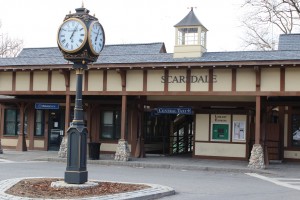
Scarsdale Train Station
Scarsdale
Long gone are the days when Caleb Heathcote established himself in 1701 in the 6.6 Sq. miles of land and named them Scarsdale, after his ancestral home in Derbyshire, England. Perhaps the same sentiment that inspired James Fenimore Cooper to write in 1821 The Spy, the first American novel, inspired the Village Board in 1922 to pass a Village-wide zoning plan that preserves the character of the Town of Scarsdale which is coextensive and operated solely as a Village. Scarsdale remains primarily a residential community of single family detached houses. A train ride of just over ½ hour into NYC is an additional incentive for working professionals to call Scarsdale home, a Village with its elegant Tudor architecture downtown, and tranquil tree lined streets that emanates a bucolic sentiment. Scarsdale is a unique community located in Westchester County, 24 miles north from New York City. Consistently rated as a leading upscale community in the US with an outstanding School District and a highly regarded Recreation and Parks Department.
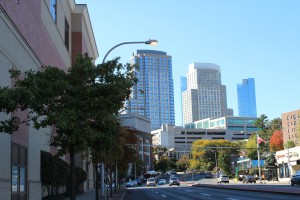
City of White Plains
White Plains
At the turn of the 17th century White Plains was farmland said to be owned by the Weckquaeskeck tribeof the Mohican nation. At that time it was called Quarropas, which was eventually settled by non-natives in 1683. After some land claim disputes in 1721 White Plains was granted a Royal Patent by King George II. In 1758 it became the (County Seat) of Westchester but it remained part of the Town of Rye until 1788 when the Town of White Plains was created. It was on July 9, 1776 that the Declaration of Independence was read in the County Courthouse (located in White Plains) just months before the end of the Battle of White Plains, won by the Continentals. After a series of transformations White Plains remains the Center of Westchester County and its commercial hub. It attracts regional and national business as well as international headquarters. The City of White Plains offers a winning combination of urban and suburban amenities. It provides a wide variety of recreation programs, quality parks and recreational facilities. The bustling downtown offers unparalleled dining and shopping options, easy access to mass transit and major highways. White Plains is also home to some outstanding cultural organizations including Art Westchester, White Plains Performing Arts Center, White PlainsArts Festival and the Music Conservatory of Westchester. If you live, work or visit White Plains, you will find a unique community filled with vibrant people and many activities.
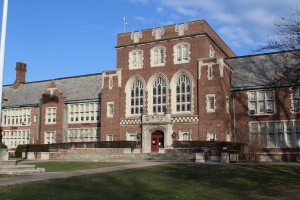
Bronxville School
Bronxville
This affluent village within the town of Eastchester was settled in 1664 by migrants from Fairfield Connecticut. It received the first laws under the Eastchester Covenant in 1665 and became incorporated as a village in 1868. Located 15 miles north of NYC in southern Westchester County this quaint village of just one square mile only began developing with the arrival of William Van Duzer Lawrence, real estate and pharmaceutical mogul in 1890. His influence can be seen throughout the community, including the historic Lawrence Park neighborhood, Lawrence Hospital Center, and Sarah Lawrence Hospital. The village was home to an arts colony in the early 20th century during which time many noteworthy houses were built by prominentarchitects. It was almost fully developed by 1940. Bronxville, looks now much the way it did 75 years ago, with some of its still-grand residences dating to the late 1800s. Bronxville is consistently ranked in a list of highest income places in the US and one of the top public schools in the Country as well.
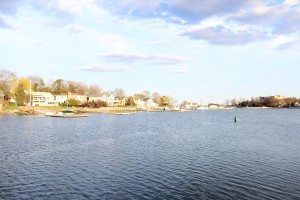
Partial View of Mamaroneck Harbor
Mamaroneck
Mamaroneck, a Native American name translated to “the place where the sweet waters fall into the sea,” is located just twenty-three miles north of New York City. Established at the mouth of a river and at the head of a harbor. John Richbell a London merchant living in Oyster Bay purchased the land in 1661 from the local Siwanoy Indians for a supply of tools, kettles, clothing and wampum. The N.Y. Legislature created Mamaroneck as a town in 1788. During the late 1800’s the beach areas along Mamaroneck became a commercial industry where fishing, shipping and manufacturing flourished. Tourists from New York City flocked there to vacation during that time as well. Today the Town of Mamaroneck-includes the entire Village of Larchmont (one square mile), the Unincorporated Area (5.7 square miles which is not part of either village), and that part of the Village of Mamaroneck west of the Mamaroneck River bordering Rye Neck (2.3 square miles). It boasts several vibrant shopping/dining areas. There is easy access to major highways and metro north for commuters. Blue Ribbon schools and abundant parks (many situated on the Long Island Sound) make Mamaroneck a perfect place to raise a family.
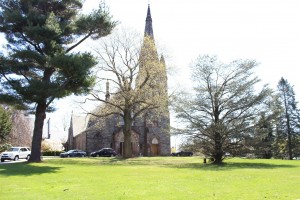
Presbyterian Church, City of Rye
Rye
Rye is the oldest non-native permanent settlement in Westchester County. In 1660 Connecticut settlers obtained it through a treaty with the Mohegan Indians and named it after their ancestors in Rye, England in 1665. It became a village in 1904 through popular vote which granted independence from the Town of Rye. In 1942 Rye was incorporated as a City. During the 1920’s, the post-war boom and the advent of parkways and commuter trains brought a rush of prospective suburbanites and summer residents to the flourishing village. Today the City of Rye is a unique blending of the old and the new, and one of America’s top earning communities. It is a residential, suburban city with award winning schools and great amenities for modern living. The City of Rye still retains its traditional atmosphere of tranquil village with many historic landmarks that bind it to its three-hundred+ year history. A city that devotes one fifth of its land to recreation and conservation and is home to Playland, a historical amusement park and designated National Historic Landmark.
- Ardsley
- Bedford
- (Bedford, Bedford Hills, Bedford Village, Katonah)
- Briarcliff Manor (Briarcliff Manor, Scarborough)
- Bronxville
- Buchanan
- Cortlandt (Cortlandt, Cortlandt Manor, Crompond, Crugers, Montrose, Verplanck)
- Croton-on-Hudson
- Dobbs Ferry
- Eastchester
- Elmsford
- Greenburgh (Greenburgh, Hartsdale)
- Harrison (Harrison, Purchase, West Harrison)
- Hastings-on-Hudson
- Irvington (Irvington, Ardsley-on-Hudson)
- Larchmont
- Lewisboro: (Lewisboro, Cross River, Goldens Bridge, South Salem, Waccabuc)
- Mamaroneck
- Mount Kisco
- Mount Pleasant (Mount Pleasant, Hawthorne, Thornwood, Valhalla)
- Mount Vernon (Mount Vernon, Fleetwood)
- New Castle (New Castle, Chappaqua, Millwood)
- North Salem (North Salem, Purdys, Croton Falls)
- New Rochelle
- North Castle (North Castle, Armonk, Banksville, North White Plains)
- Ossining (Ossining Town, Ossining Village, Maryknoll)
- Peekskill
- Pelham
- Pelham Manor
- Pleasantville
- Port Chester
- Pound Ridge (Pound Ridge, Scotts Corners)
- Rye
- Rye Brook
- Scarsdale
- Sleepy Hollow
- Somers (Somers, Amawalk, Baldwin Place, Granite Springs, Lincolndale, Shenorock)
- Tarrytown (Tarrytown, Pocantico Hills)
- Tuckahoe
- White Plains
- Yonkers
- Yorktown (Yorktown, Jefferson Valley, Mohegan Lake, Shrub Oak, Yorktown Heights)





